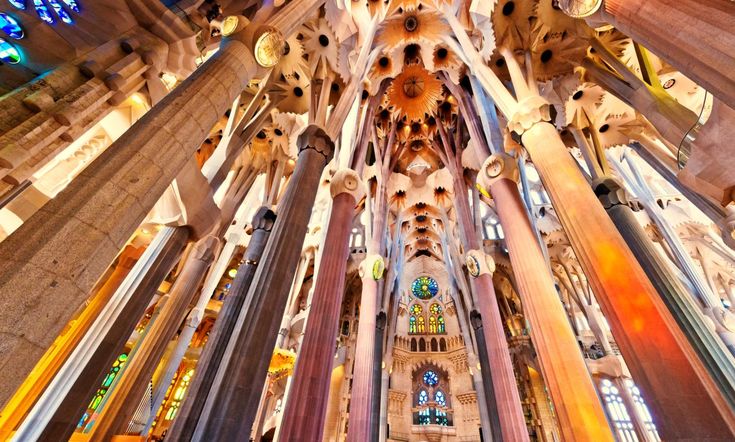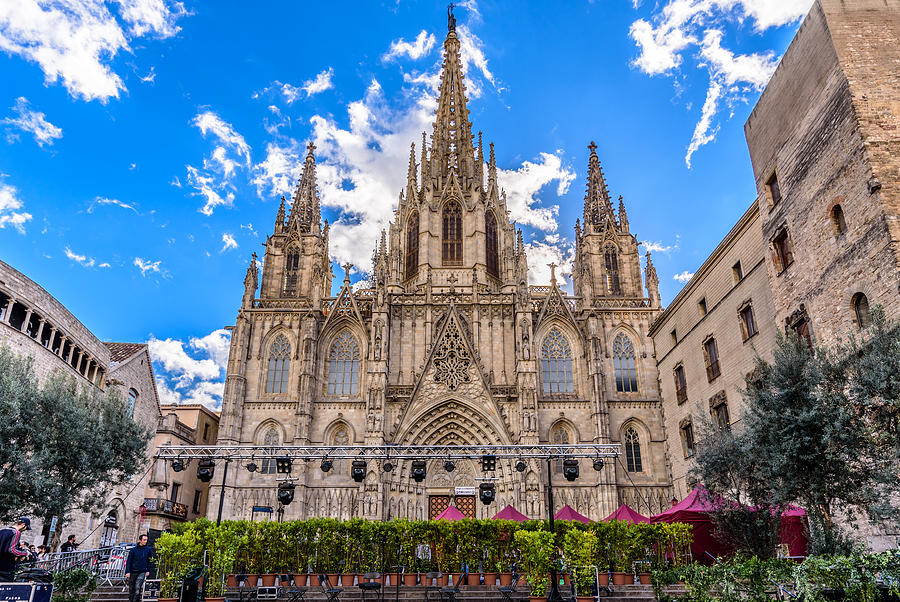Barcelona 2023 – La Sagrada Familia
Sagrada Familia Barcelona. The Sagrada Famila (Sacred Family) temple is the world famous unfinished church by Antonti Gaudi. Virtual tour Its full name is ‘Temple Expiatori de la Sagrada Familia’. This is Barcelona’s most famous church designed by the Spanish/Catalan architect Antoni Gaudi. It’s free to see from outside, but worth seeing inside and a good tip is to buy advance skip-the-line Sagrada Familia tickets to avoid long lines.
The Sagrada familia is unfinished but still Barcelona’s most famous landmark and the most visited tourist attraction in Barcelona.
Opening times Sagrada Familia
(Can change due to special events and services)
November, December, January, February
9 am to 6 pm
March
9 am to 7 pm
April, May, June, July, August, September
9 am to 8 pm
October
9 am to 7 pm
Special days
December 25, 26, January 1 and 6,
9 am to 2 pm
TICKETS skip-the-line Sagrada Familia
TICKETS Sagrada Família Tour
The construction of the incredible Sagrada Familia temple started in 1882, when Gaudi agreed to work on a project for a new and magnificent church in Barcelona.
It is still not finished. In 2013 about 65% of the temple had been completed. It is hoped that the church will be finally finished in 2026, which will be 100 years after Gaudi die. but this might be delayed by the Covid epidemic.
New milestones for La Sagrada Família are when the ‘Torre de la Mare de Déu’ – ‘torre de María’ – will be finished this year on 8th December 2021.
Mary’s Tower will be the second tallest in the Sagrada Família, when all the towers are finished. It will be crowned by a twelve-pointed star which will bring the total height of Mary’s tower to 138 meters.
Future milestones are the completion of the temple’s tallest tower, the ‘Tower of Jesus – La torre de Jesús’, which will be 172.50 meters high and feature a transparent elevator that goes up 60 meters in the central tower to a viewing point at 144 meters altitude. The tower will be crowned by a large four-armed cross.
The current lead architect is Jordi Faulí who leads a team of 40 construction workers.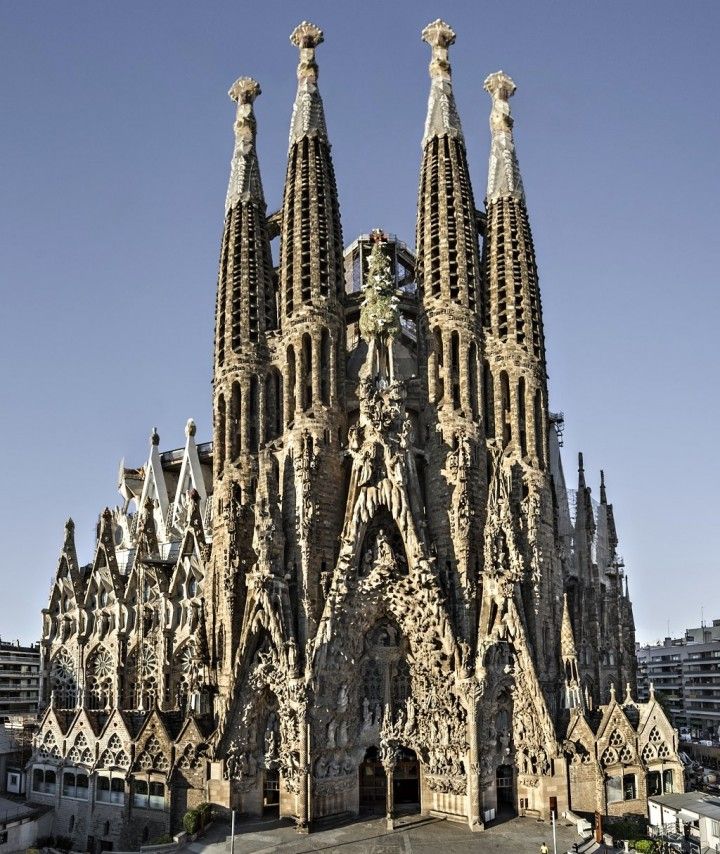
It is expected that he will be the final architect, when this magnificent temple is finally finished 144 years after the building work started.
Live webcam Sagrada Familia
On 7th November 2010 Pope Benedict XVI visited Barcelona to consecrate the Sagrada Familia as a basilica. Visit the Sagrada Familia website for worship times, masses (missa) and services.
The waiting time to buy entrance tickets can be up to 1 hour, especially in peak season. Buy Sagrada familia tickets online. Or book a Gaudi & Sagrada Família Tour which includes skip-the-line admission.
Hotels near Sagrada Famlia Barcelona
Open FULLSCREEN VERSION of map
Pictures Barcelona’s Sagrada Familia
24 hour parking lot near Sagrada Familia
BBC video consecration Sagrada Familia
Hotels near Sagrada Familia
TICKETS Gaudi and Sagrada Família Tour
How will Sagrada Familia look finished
YouTube how finished Sagrada Familia will look.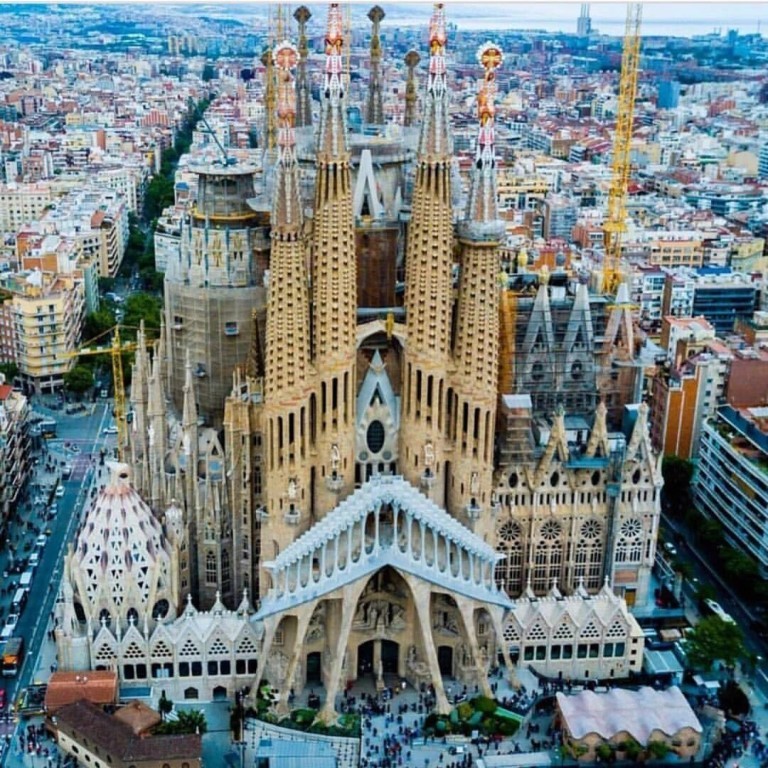
About Catalan architect Antoni Gaudi
10 Most Stunning Churches In Spain That Are A Work Of Art
The Spanish charm is such you’ll have your heart stolen with just a quick glimpse. Where wine, Tapas and Flamenco set the mood right, getting your spirits high. Where tomatoes are smashed on each other as a celebration of La Tomatina. Where art and architecture define precision and brilliance. Yes! Spain is all that and more. When it comes to churches in Spain, we know we have plenty of options to look at. But, there are some masterpieces that go beyond spirituality and artistry.
This is the list of most stunning churches in Spain, which alone can be a major pull for you!
1. La Sagrada Familia Church, Barcelona
Image Source
The icon of Spanish tourism, La Sagrada Familia Church is the largest church in Spain. It will lure you with its intricacy portrayed not just in the interior but also through its delicately crafted facade. Though it still is under construction, it doesn’t fail to attract people with its beauty and spiritual significance.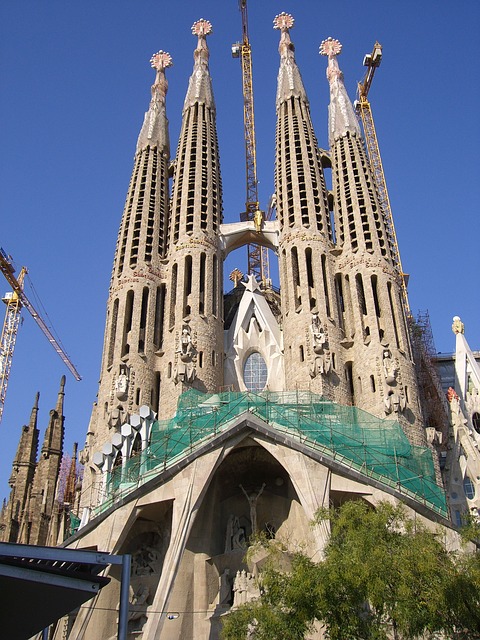
A list of churches in Spain remains incomplete if we don’t find mention of the La Sagrada Familia, as it stands as an inspiring epitome of Art Nouveau style of architecture as well.
Suggested Read: Visit These 7 Places In Barcelona In April To Have An Incredible Summer Vacation
2. Burgos Cathedral, Burgos
Image Source
Burgos Cathedral dates back to 13th century when it was commissioned to be built by King Ferdinand III of Castile. The completion took three more years, but the final outcome was worth all these years. Even today, just a glimpse of this marvel will convince you this is a work of finest art and architecture, crafted with an attention to detail. Built with Gothic style of architecture, Burgos Cathedral is dedicated to Virgin Mary and catches attention with its octagonal spires, sculptures of Biblical figures and saints.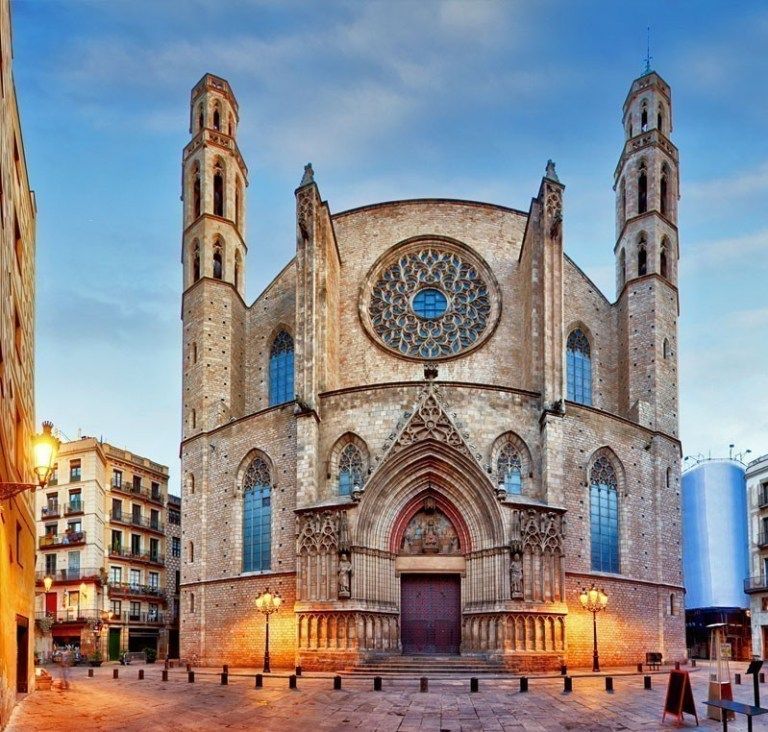
Suggested Read: 10 Spanish Mosques: Impressive Historic Islamic Architecture In Spain
3. Basilica of Our Lady of the Pillar, Zaragoza
Image Source
Located by the stunning Ebro River, Basilica of Our Lady of the Pillar looks like something out of fantasies. This structure flaunts a mesmerizing blend of three architecture styles, namely – Neoclassical, Baroque and Rococo. As you step inside, you will be greeted by the artistic creations of Francisco Goya, a revered painter.
Beside its stunning artistry, the Basilica of Our Lady of the Pillar has legends to narrate; as one mentions that it was built by St. James post his apparition with Saint Mary. St. James is known to introduce christianity to Spain.
Must Read: 10 Best Churches In Zurich One Must Visit In 2022 To Connect With Your Inner Self Once Again!
4. Temple Expiatori del Sagrat Cor, Barcelona
Image Source
Perched atop Mount Tibidabo , Temple Expiatori del Sagrat Cor is also known as Expiatory Church of the Sacred Heart of Jesus.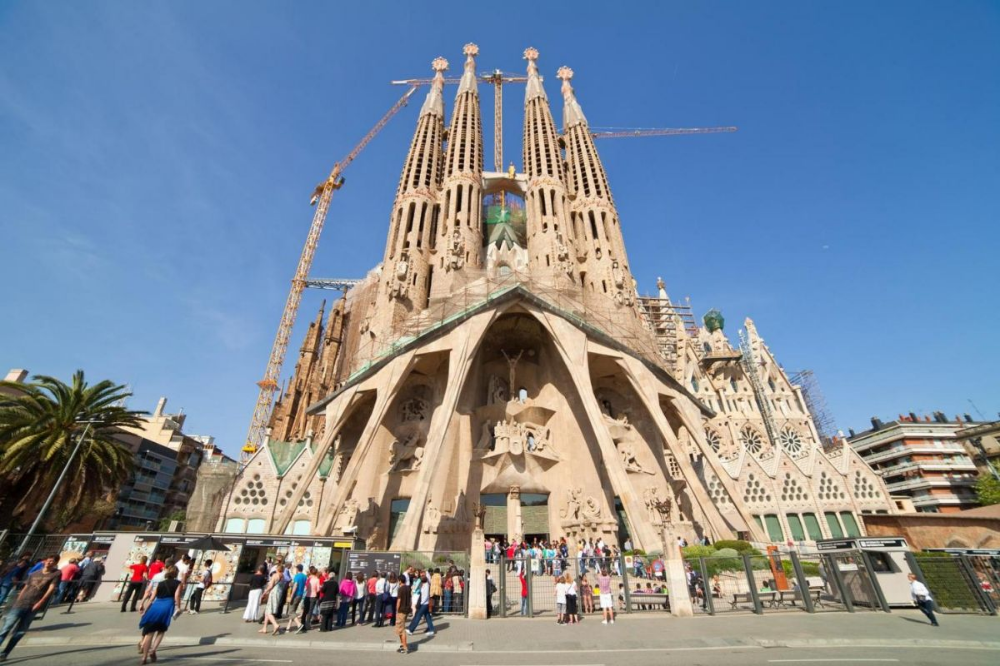
5. Cathedral of Santa Maria of Palma, Palma
Image Source
One of the most stunning churches in Spain, Cathedral of Santa Maria of Palma is located on the Island of Mallorca. Its construction began in the 13th century and was completed by 1601. Considered among the tallest cathedrals in Spain and Europe, the structure was built on the site where once stood a Moorish Mosque.
The Cathedral of Santa Maria of Palma is also called La Seu and you will witness a blend of Gothic, Gaudi and Catalan architecture here.
Must Read: 8 Best Spanish Cuisines That Will Make You Fall In Love With Spain All Over Again!
6. Santiago de Compostela Cathedral, Santiago
Image Source
An architectural marvel of Spain, Santiago de Compostela Cathedral is built in Baroque style.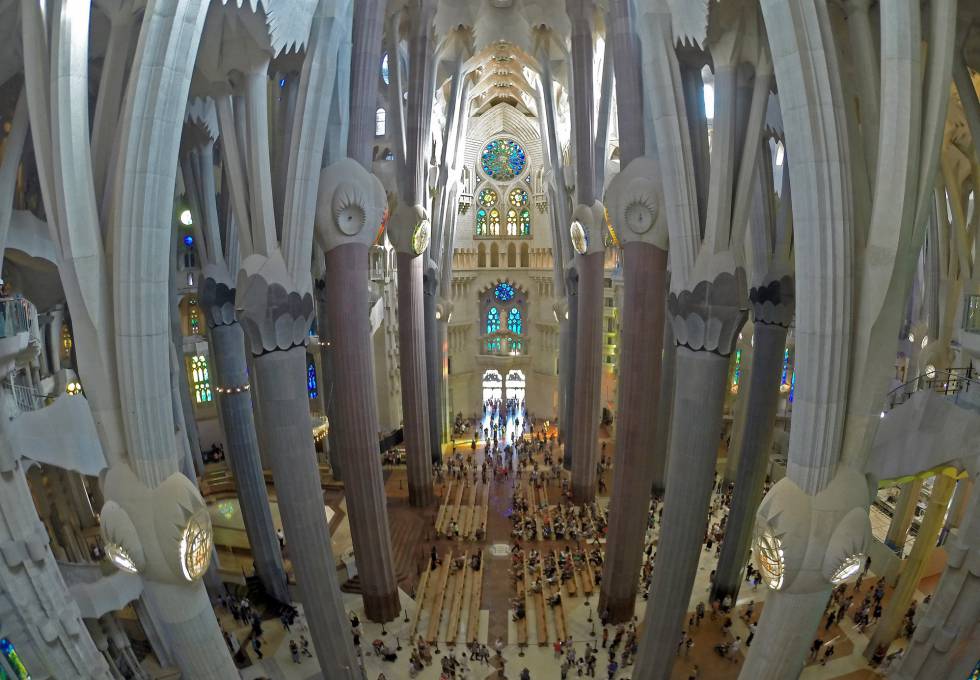
Suggested Read: 15 Best Beaches In Spain To Bask In The Tropical Sun For An Exotic European Vacay!
7. Mezquita of Cordoba, Córdoba
Image Source
A highly-instagrammed spot for sure, Mezquita of Cordoba is also called the Mosque-Cathedral of Cordoba. Like many churches in Spain, this one too boasts of an intriguing past. It dates back to seventh century and back then it was a Visigoth church, but was later converted into an Islamic shrine. However, it was reverted to a Catholic religious spot in 13th century. In 16th century Renaissance nave was built in Mezquita of Cordoba, and different architectural styles were also seemed to be blended which stands as a symbol of harmony as well.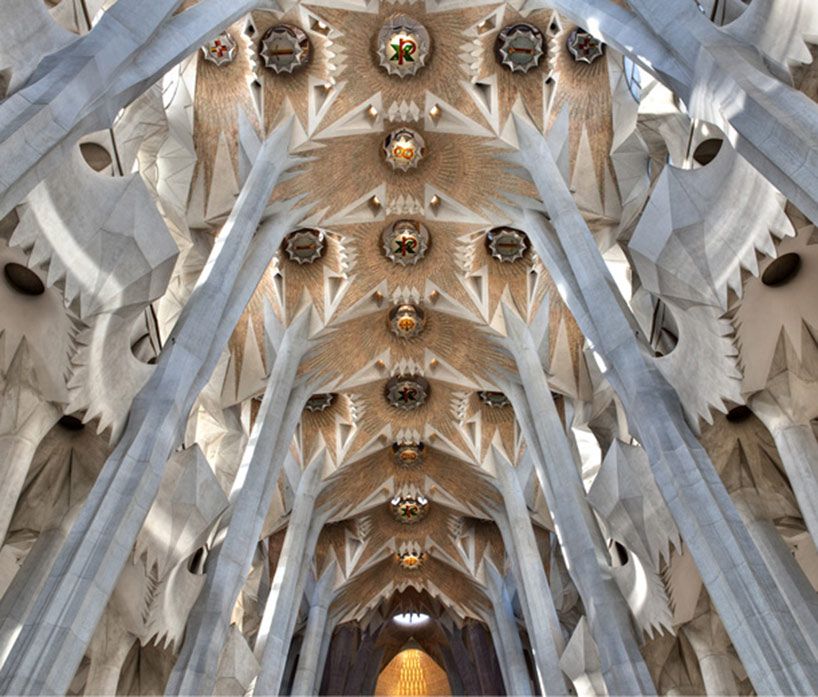
Suggested Read: 10 National Parks Of Spain That Will Take The Travelers To Another World
8. Seville Cathedral, Seville
Image Source
As the horse carriages stand right outside this Gothic Cathedral, you will be convinced you’ve traveled back in time. This was built in the sixteenth century and is centrally located in the city of Seville. It is among the most important churches in Spain as it serves as the final burial spot of Christopher Columbus. Talking of its aesthetics the spires and embellishment are a treat to the eye, conspiring to bewitch the beholder.
Suggested Read: 11 Enticing Spain Road Trips For A Soul-Stirring Experience
9. Toledo Cathedral, Toledo
Image Source
Another among the Gothic churches in Spain, Toledo Cathedral was commissioned in thirteenth century by the Ferdinand III of Castile. It was built with white limestone and today it boasts of housing a magnificent collection of big precious stones.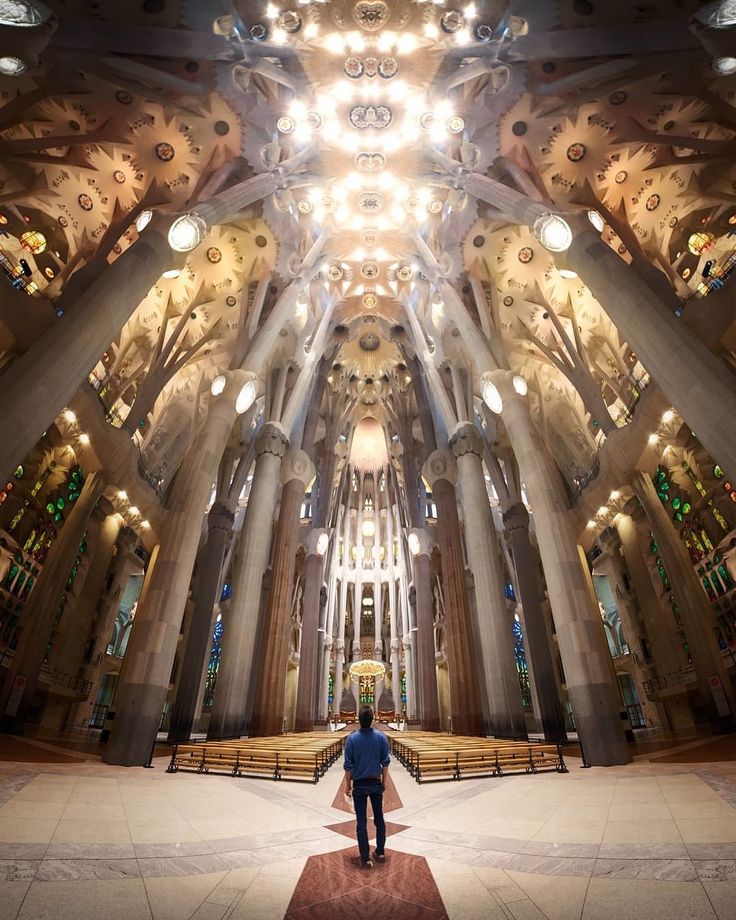
Suggested Read: 21 Captivating Spain Tourist Attractions That Will Make You Pack Your Bags In 2022
10. Santa Maria la Real de Covadonga, Covadonga
Image Source
Settled amidst lush greenery, Santa Maria la Real de Covadonga was built during the end of nineteenth century. This neo-Romanesque was built using red-hued limestone. This is one of the most beautiful churches in Spain and is jotted in the bucket list of many. Since it is located in a village, this would be an ideal visit for anyone wanting to sneak a peek of real Spanish culture.
Further Read: Honeymoon in Spain: A Romantic Espanol Vacation
Spain is a country where you will witness the best of modern infrastructure and masterpiece architecture from the past. Many a times there’s a blend of both in just one structure. So, to make the most of your Spanish vacation opt for Europe tour packages with Travel Triangle.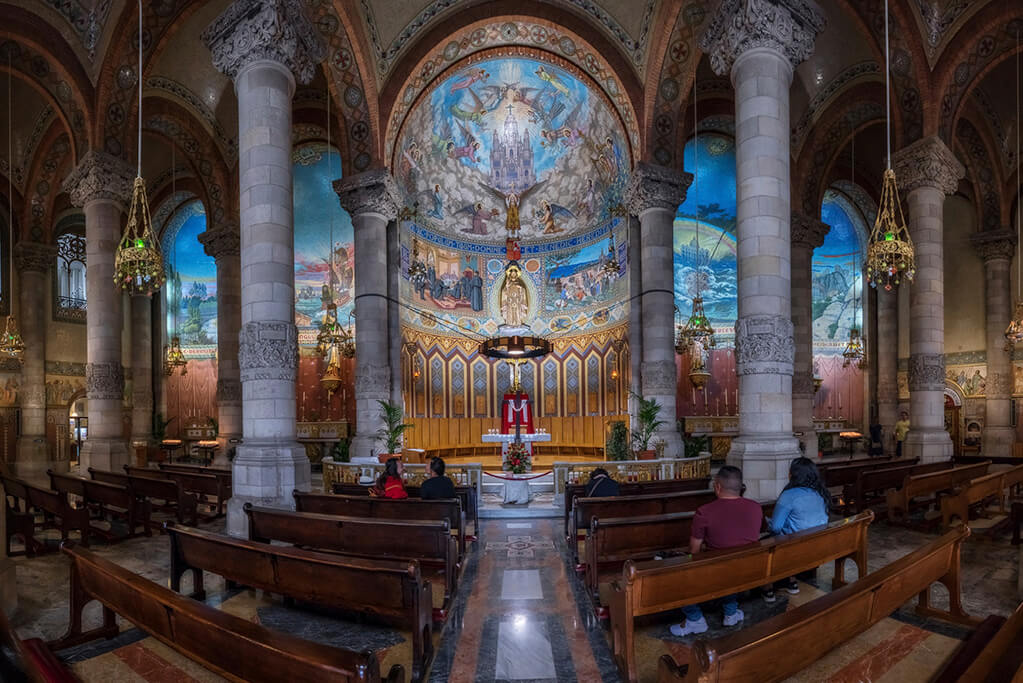
Disclaimer: TravelTriangle claims no credit for images featured on our blog site unless otherwise noted. All visual content is copyrighted to its respectful owners. We try to link back to original sources whenever possible. If you own the rights to any of the images, and do not wish them to appear on TravelTriangle, please contact us and they will be promptly removed. We believe in providing proper attribution to the original author, artist or photographer.
Please Note: Any information published by TravelTriangle in any form of content is not intended to be a substitute for any kind of medical advice, and one must not take any action before consulting a professional medical expert of their own choice.
Frequently Asked Questions About Churches In Spain
What is the church timing in Spain?
Most of the churches under religious sites for tourists are open from 09:30 Am to 07:00 PM. A few of the modern churches are open on Sundays only.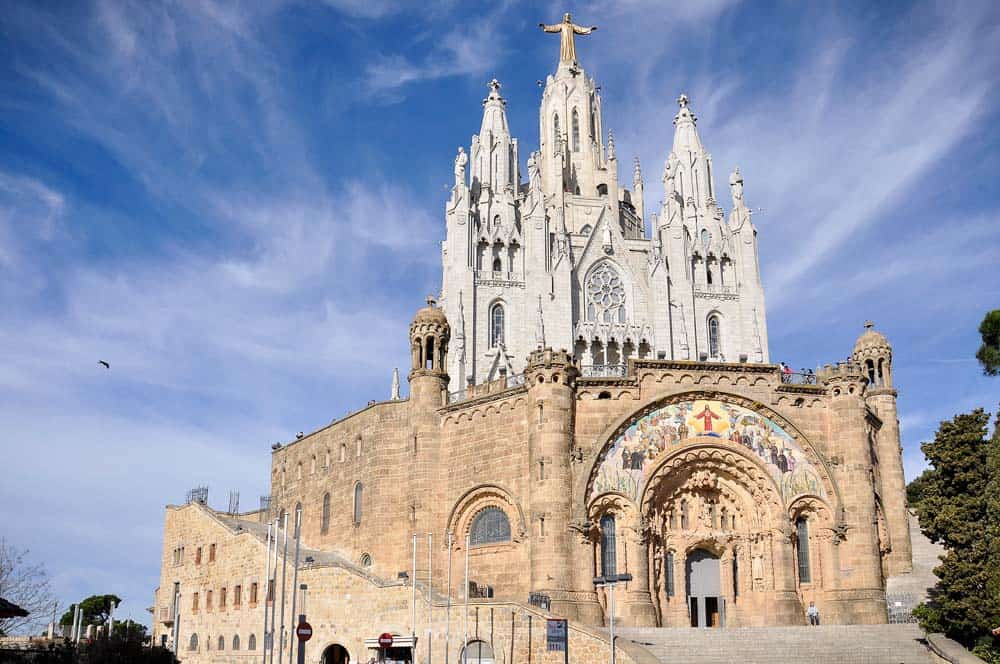
Which architectural style can be seen in Churches in Spain?
Churches in Spain are of the Baroque style, Gothic style, Neoclassical style, Nouveau style, Rococo style, and Romanesque style.
Can tourists of any religion and ethnicity enter the churches present in Spain?
Yes, as of now tourists of any religion and ethnicity can enter the churches present in Spain. It can be for prayer, event and to see the architectural values.
Which church in Spain takes entry fees from tourists?
La Sagrada Familia Church in Barcelona takes the entry fee of Euro Dollar 17 to 32. The charges are inclusive of the audio guide, and access to the church tower.
Which is the best season to visit the churches present in Spain?
Tourists can visit the churches present in Spain in any season.
Which church in Spain is the most visited one in Spain among international tourists?
La Sagrada Familia Church, Barcelona in Spain is the most visited one in Spain among international tourists.
Which church pilgrimage is under UNESCO World Heritage Site and an important walking trail route for the Spain nationals?
The Camino de Santiago church pilgrim route from Northern Spain is a UNESCO World Heritage Site and an important walking trail route for the Spain nationals.
Churches in Spain conduct masses in what languages?
The church masses are available in Spanish and English in Spain.
Looking To Book An International Holiday?
Book memorable holidays on TravelTriangle with 650+ verified travel agents for 65+ domestic and international destinations.
interesting facts about the famous project of Gaudi
Spain is not only the sea and beaches, but also museums, cathedrals, Gothic quarters, attractions, bullfighting. And yet – this is the birthplace of Antonio Gaudi, the author of world-famous architectural structures.
History of creation
The idea of erecting a church in honor of the Holy Family originated in 1874, the first stone of its foundation was laid in 1882, and construction continues to this day. The first project of the temple was developed by the architect del Villar, according to the original plan, the basilica was to have the shape of a Latin cross and be executed in the neo-Gothic style. However, already in 1883 Villar was replaced by Gaudí. He changed the original project, completely transforming both the shape and structure of the building. The architect wanted the cathedral to be crowned with several towers soaring upwards, and each element of the decoration had a symbolic meaning.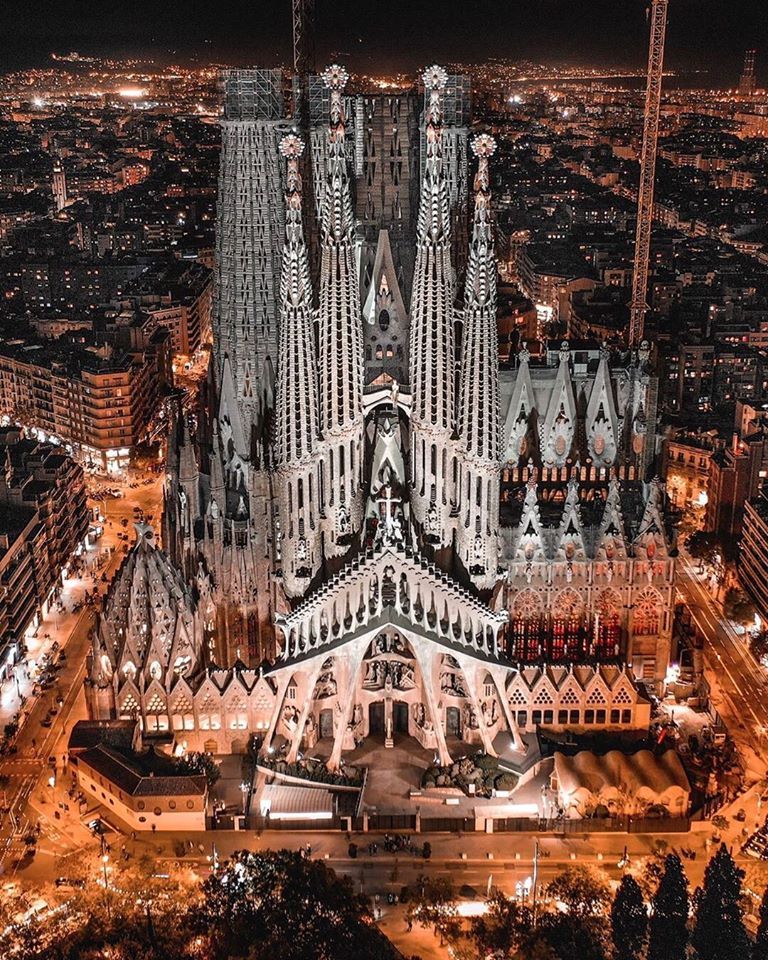
It must be said that the architect not only designed the church, but also collected donations for the construction, during the first 36 years it progressed very slowly. The crypt was completed only in 1891, and in 1900 the facade of the Nativity, the chapel and part of the inner wall were completed. In 1911, Gaudí designed the Passion façade, and a little later, the Glory façade. The architect’s team carefully worked out every detail, and Antonio himself improved the symbolic content of the elements of the cathedral.
After Gaudí’s death, Domenech Sugranes continued to work on the project. Before his death in 1938, he built three belfries of the Nativity facade and a ceramic cypress at the main entrance. Construction was interrupted by the Civil War, and this break lasted until 1952. In 1977 the Passion façade was erected, in 1986 sculptural decorations and stained-glass windows were created.
Architectural features
The church, consisting of five naves, has the shape of a Latin cross. The large apse consists of seven chapels and a bypass gallery located behind the choir. After the completion of the project, the building will be crowned with eighteen towers. Twelve of them are dedicated to the apostles, four more surround the highest tower of Jesus, and near the asp is the smaller bell tower of the Virgin Mary. As conceived by Gaudi, the Sagrada Familia is decorated with traditional symbols – a calf (Luke), an angel (Matthew), a lion (Mark) and an eagle (John).
The facade of the Nativity, created during the lifetime of the chief architect, is formed by three portals, symbolizing Faith, Hope and Mercy. They are decorated with sculptures on the theme of the earthly life of Christ:
- “The Birth of Jesus”;
- “Adoration of Shepherds and Magi”;
- “Jesus and the Pharisees”;
- Introduction to the Temple.
The bell towers are reminiscent of sandcastles, each dedicated to an apostle and adorned with his sculpture. In the decoration of the Sagrada Familia, Gaudí used quotations from the Bible, translated into several languages.
Interior arrangement and interior of the temple
Realizing that the church would not be completed during his lifetime, Gaudí designed most of its interior details. Abandoning straight lines, the architect used unusual shapes – hyperboloid, helicoid, conoid. The interior of the cathedral is subject to geometric laws, it has round windows and stained-glass windows, helicoidal stairs, ellipsoids. The main load-bearing element of the building is the columns, which differ in height and section thickness. Thanks to the original stained-glass stucco, on a sunny day, temple guests can watch the bewitching play of colors.
Interesting facts about the Sagrada Familia
Sagrada Familia is Barcelona’s calling card, its well-known symbol.
- in 2005 the church was included in the UNESCO World Heritage List;
- the construction of the structure began and continues only on private donations;
- in 2008, more than 400 Spanish artists demanded to stop the restoration, in their opinion, the project of the great architect is being “finished” carelessly and ineptly;
- construction takes so long due to the difficulty of producing unusually shaped stone blocks, they require individual processing;
- in 2010, the Pope consecrated the cathedral, recognizing it as fit for church services.
You can go on an excursion to the Sagrada Familia on your own or with a guide.
Sagrada Familia in Barcelona (Spain)
Sagrada Familia in Barcelona is a majestic building that is considered a symbol of the city.
Contents
History of Sagrada Familia
The idea that prompted the start of construction came from a wealthy Spanish bookseller at the end of the 19th century. He was a believer, and after visiting the Vatican, he was deeply impressed by what he saw. Upon his return to Catalonia, he began to raise funds for the construction of a magnificent church. He collected such a large amount that allowed him to build a whole temple.
In the same year, a plot of land outside of Barcelona was specially purchased for the needs of the future building. At the moment, the city has grown that construction continues in a densely populated metropolis. Then all the work took place outside the city limits.
Francisco Villar has been appointed Chief Architect for the Sagrada Familia. Under his leadership, the foundation of the future cathedral was laid.
However, the construction was not abandoned. The baton was passed on to the ambitious and charismatic architect Antonio Gaudí. Under his leadership, the original project has undergone major changes. The finished building was to be made in the Art Nouveau style. The external design of the temple resembled a cobweb, however, in terms of complexity and financial resources spent, it was in many ways superior to the traditional architectural style for Catholicism.
Architectural features of the Sagrada Familia
The outer part of the building was supposed to have a large number of towers directed upwards. The interior decoration personified a number of gospel elements. The height of the central spire with a cross on the tip was 170 meters: 1 meter lower than Montjuic, which is considered a perfect creation of God.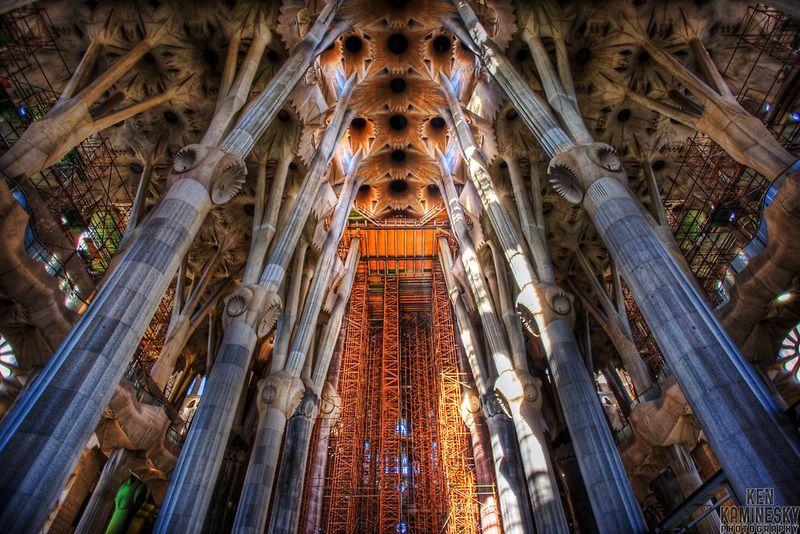
The basis of the church is a traditional Catholic cross. According to the complexity of the construction and installation, as well as the peculiarities of decoration, the Latin cross of the Sagrada Familia surpasses all famous Spanish churches.
Antonio Gaudí’s final architectural design was that the temple should have eighteen spiers. Twelve of them personified the apostles, one – the incarnation of the Virgin Mary, four were intended to display the evangelists. The highest tower of the cathedral is 170 meters. She is considered the personification of Jesus Christ.
During the service, 10,500 people can be in the cathedral, including 1,500 singers and 9,000 parishioners. Although the temple is still under construction, at the moment it is included in the World Heritage List according to the international organization UNESCO. Estimated completion date for repairs is 2026. It will be 100 years since the death of Antonio Gaudí.
General characteristics of the facades of the Sagrada Familia Cathedral
Conventionally, the external exposition of the temple is represented by three elements:
1.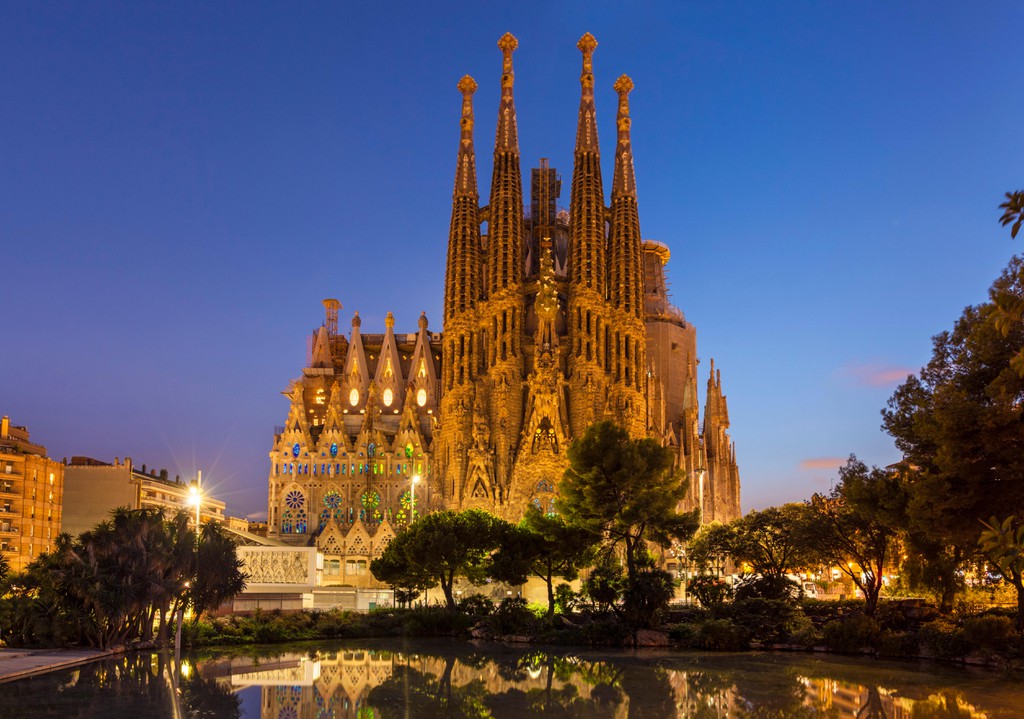
2. Passion Facade. As conceived by Gaudi, the construction of this façade was postponed indefinitely. The reason for this was a rather bold and charismatic interpretation of the trials that Christ endured. The chief architect of the Sagrada Familia believed that the priority construction of this facade would scare away the parishioners and negatively affect the success of the project. This facade is made in a strict and solemn form.
3. Facade of Glory. This is the final stage of the construction of the cathedral. He personifies the resurrection of Christ, death, divine judgment, as well as glory and eternal life in heaven. Hell, which is intended for sinners, did not escape attention. The construction of the facade began in 2002 and continues to this day.
The interior of the Sagrada Familia
The interior of the temple is represented by a large number of sculptures and stained-glass windows of all types and sizes. A large number of windows, as well as unique stained glass moldings – all this contributes to the excellent illumination of the temple. When the sun hits the colored stained-glass windows, you can watch the bewitching play of colors.
The peculiarity of the interior decoration of the temple is that in it each surface consists of a mosaic, painting or fresco.

